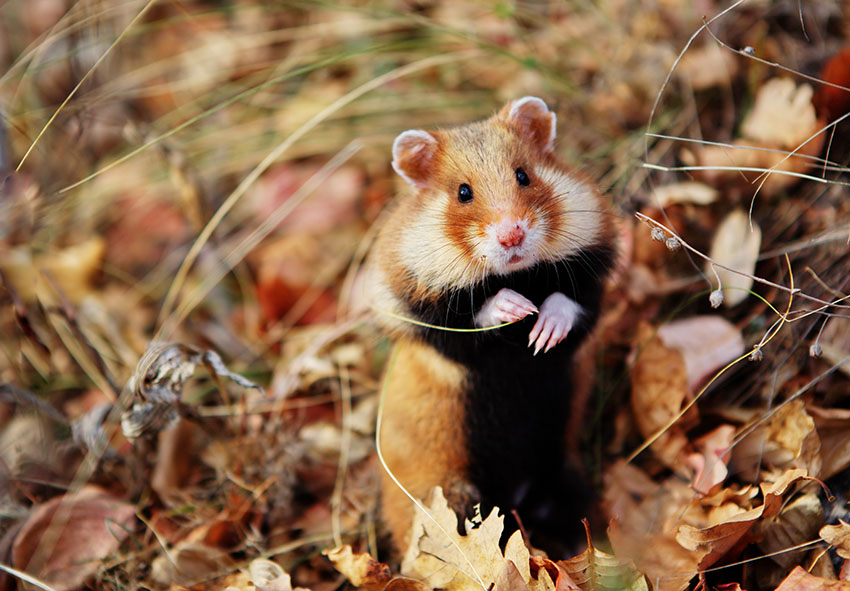Hamsters are small members of the rodent family, related to mice, rats, gerbils and Guinea pigs. The biggest of the domesticated breeds is the Syrian or Golden hamster (Mesocricetus auratus - formerly Cricetus auratus, before recent genetic analysis placed the species in the subfamily Mesocricetus) which can reach a length of 7 inches. The largest member of the family in the wild is the European hamster (Cricetus cricetus), which measures between 8 and 14 inches in length, with an extra 2 inches of tail.
Hamsters have short legs and short tails, adapted for a life underground. Although short, their legs are very strong to enable them to dig tunnels with ease. This makes them something like a very athletic Mole, and unlike that truly subterranean (and unrelated) creature, they can walk up to 8 miles in a single night foraging for food.

The compact and beautifully adapted hamster
The tail, ears and feet are covered in a fine fur and the rest of the body is covered in a much thicker fur. This helps keep the hamster warm in cold environments. One of the most famous characteristics of hamsters is their ability to stuff loads of food into their cheeks. They have special pouches which can expand as far out as their shoulders. This enables them to forage away from their burrow and carry back lots of the food they find.
The Five Senses
- Eyesight
Hamsters are most active at dawn and dusk, and their large eyes reflect this fact. They don't have great eyesight, though, as you'll soon notice by their vague and unfocused stare. They appear to lack any perception of depth and distance, which is why a hamster who trundles across a solid surface will plunge from the edge with no apparent sense of how far the fall might be. This poor eyesight does not prevent them from climbing fearlessly up the sides of their enclosures - or shelving and curtains, if they're outside the cage - and they come down again by the simple but alarming ploy of simply letting go. This makes them very entertaining to watch - and they are sufficiently fat and furry to avoid hurting themselves in the tumble.A hamster that detects movement from above will flip onto its back so that it can defend itself with it's feet and teeth. In the wild this is a defence against birds, and pet hamsters have the same reaction to human hands hovering above them. You might simply be wanting to pick up your pet, but the hamster interprets it as a potential attack. This is why you should always approach your hamster from the front, so it can see you coming.
- Smell
What a hamster lacks in eyesight she makes up for with her keen sense of smell. At the slightest movement, her little nose will start to twitch. She approaches life nose-first, and will home in on favorite foods such as sunflower seeds in her food dish, even if they are buried under lots of other stuff. Fresh greens are usually a favorite too, and may even rouse a sleeping hamster who can't resist a nibble. Hearing
Hamsters have excellent hearing. They keep their ears are upright to catch every sound, like twin mini radar dishes. Only when asleep do the ears relax. Hamsters soon come to recognize sounds associated with food, and the rustle of the food packet and the clinking of the food dish will be their signal that the yummy stuff is on the way. Hamsters will learn to recognize your voice too, so you should always talk to your pet. She will come to you expecting food and attention. Don't expect much of a verbal response, though.Taste
Hamsters are omnivores - that is, they eat a varied diet including vegetables and meat. In the wild their main food is seeds and grasses, but they will happily nibble on an insect too.Touch
A hamster's front paws are like little hands. Watch them feeding or cleaning themselves and you'll notice how agile and dexterous those little fingers are.Whiskers
For nocturnal animals like hamsters, whiskers play an important role while navigating through the darkness. Whiskers are sensitive, and hamsters dislike having them tampered with. Avoid pulling them or even stroking them - it may feel good to you, but the hamster will find whisker-handling uncomfortable.

Comments
Phil, 26 April 2023
Great article. I loved how humor was used in the descriptions. My hamsters definitely know the yummy stuff is coming when I start preparing their meals
Skyla, 19 December 2011
this taught me more about hamsters. I love my robovoski Raisin!